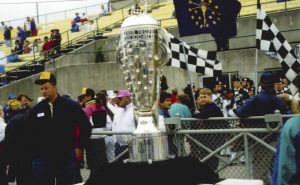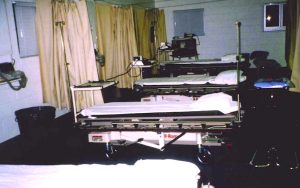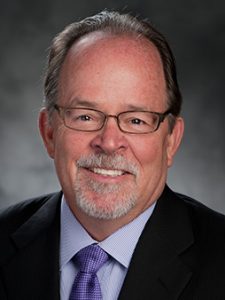Advocate doctor part of history at Indy 500
By Paul Johnson For Chronicle Media — May 25, 2016

Dr. James Nevin saw many trophy ceremonies in the winner’s circle while serving as a physician at the Indianapolis 500 from 1983-95. (Photo courtesy Dr. James Nevin)
Dr. James Nevin is going back to a familiar place this Memorial Day weekend, the Indianapolis 500, now as a fan.
The vice president of medical management at Advocate BroMenn Medical Center in Normal spent 1983-95 at the race in a much different role — as track physician.
“It’s not the same (as a fan) after being on the inside,” Nevin said. “I’m smiling now. It sure was fun.”
Nevin stumbled upon that job while going to medical school at Indiana and continued to work the race for years, even when he was living in Naples, Fla., when he would fly up for the race every year.
He still makes the trek to The Brickyard in Indianapolis for the big race every couple of years or so with some close friends and family, and still sees plenty of familiar faces.
The racing community and the medical care involved with it has changed dramatically in the past 21 year since Nevin roamed a medical center housed in a big tent.
“It really was a testing ground,” Nevin said. “The medical center was a M.A.S.H. unit. Now, it’s a state-of-the-art facility.”
Nevin was involved in the Indianapolis 500 during a period that featured some of racing’s biggest legends. Luminaries such as Emerson Fittipaldi, Arie Luyendyk, Rick Mears, Bobby Rahal, Al Unser Jr. and Jacques Villeneuve won the race while Nevin manned the medical center.
Nevin and his colleagues watched those races from closed circuit television inside the medical tent, waiting to see if and when they needed to spring into action.

Dr. James Nevin described the Indianapolis 500 track hospital he worked in from 1983-95 as a M.A.S.H. unit. The medical center is more state-of-the-art today, he said. (Photo courtesy Dr. James Nevin)
While race fans may remember the 1986 race, the closest and fastest finish up to that time with Rahal edging Kevin Cogan and Mears, Nevin’s memories involve some of the darker moments in the race’s history.
In 1987, the first spectator killed in a racing-related incident at the 500 since 1938 required Nevin’s attention. Tony Bettenhausen lost one of his tires and Roberto Guerrero’s car hit it with his nose, before the tire went flying into the stands, killing a fan.
“I was on the ambulance crew,” Nevin said. “We could see the tire. That was a chaotic scene. I remember riding in the back (of the ambulance) with him. That was a bizarre experience.”
Nevin recalled the 1992 race, a cold, windy week that resulted in numerous wrecks and serious injuries. There were several serious crashes during the week, and then in the race itself as 13 cars were eliminated. Jeff Andretti suffered the worst injuries, breaking his foot and leg.
That race led to several new safety precautions.
“I have a photo of nine helmets all lined up of racers that had come in,” Nevin said. “By that time, I had enough experience where I knew some of them and they called me Doc. Roberto Guerrero spun out on the pace lap. We were busy that day.”

Helmets line a table at the Indianapolis 500 track hospital in 1992 following a series of crashes left many drivers inured. (Photo courtesy Dr. James Nevin)
There are many great memories that Nevin has, memories that only a handful of people had the opportunity to experience.
“l’d stand between turns one and two on the track and give the drivers a thumb’s up as they passed on the parade lap,” Nevin said. “We took a lap around the track after every day of the week. It’s the greatest racing spectacle in the world. You can get caught up in that.”








